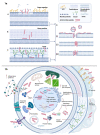Multitalented Synthetic Antimicrobial Peptides and Their Antibacterial, Antifungal and Antiviral Mechanisms
- PMID: 35008974
- PMCID: PMC8745555
- DOI: 10.3390/ijms23010545
Multitalented Synthetic Antimicrobial Peptides and Their Antibacterial, Antifungal and Antiviral Mechanisms
Abstract
Despite the great strides in healthcare during the last century, some challenges still remained unanswered. The development of multi-drug resistant bacteria, the alarming growth of fungal infections, the emerging/re-emerging of viral diseases are yet a worldwide threat. Since the discovery of natural antimicrobial peptides able to broadly hit several pathogens, peptide-based therapeutics have been under the lenses of the researchers. This review aims to focus on synthetic peptides and elucidate their multifaceted mechanisms of action as antiviral, antibacterial and antifungal agents. Antimicrobial peptides generally affect highly preserved structures, e.g., the phospholipid membrane via pore formation or other constitutive targets like peptidoglycans in Gram-negative and Gram-positive bacteria, and glucan in the fungal cell wall. Additionally, some peptides are particularly active on biofilm destabilizing the microbial communities. They can also act intracellularly, e.g., on protein biosynthesis or DNA replication. Their intracellular properties are extended upon viral infection since peptides can influence several steps along the virus life cycle starting from viral receptor-cell interaction to the budding. Besides their mode of action, improvements in manufacturing to increase their half-life and performances are also taken into consideration together with advantages and impairments in the clinical usage. Thus far, the progress of new synthetic peptide-based approaches is making them a promising tool to counteract emerging infections.
Keywords: antibacterial; antifungal; antimicrobial peptides; antiviral; peptide-based therapies; synthetic peptides.
Conflict of interest statement
The authors declare no conflict of interest.
Figures


Similar articles
-
Recent advances in the research and development of marine antimicrobial peptides.Curr Top Med Chem. 2013 Aug;13(16):2026-33. doi: 10.2174/15680266113139990127. Curr Top Med Chem. 2013. PMID: 23895098 Review.
-
Advancements in peptide-based antimicrobials: A possible option for emerging drug-resistant infections.Adv Colloid Interface Sci. 2024 Nov;333:103282. doi: 10.1016/j.cis.2024.103282. Epub 2024 Sep 6. Adv Colloid Interface Sci. 2024. PMID: 39276418 Review.
-
Perspectives for clinical use of engineered human host defense antimicrobial peptides.FEMS Microbiol Rev. 2017 May 1;41(3):323-342. doi: 10.1093/femsre/fux012. FEMS Microbiol Rev. 2017. PMID: 28521337 Free PMC article. Review.
-
Human Oral Defensins Antimicrobial Peptides: A Future Promising Antimicrobial Drug.Curr Pharm Des. 2018;24(10):1130-1137. doi: 10.2174/1381612824666180403114615. Curr Pharm Des. 2018. PMID: 29611481 Review.
-
Natural-based Antibiofilm and Antimicrobial Peptides from Microorganisms.Curr Top Med Chem. 2018;18(24):2102-2107. doi: 10.2174/1568026618666181112143351. Curr Top Med Chem. 2018. PMID: 30417789 Review.
Cited by
-
Evaluation of the Synthetic Multifunctional Peptide Hp-MAP3 Derivative of Temporin-PTa.Toxins (Basel). 2023 Jan 5;15(1):42. doi: 10.3390/toxins15010042. Toxins (Basel). 2023. PMID: 36668862 Free PMC article.
-
Effects of dietary cecropin on growth performance, diarrhea rate and intestinal health of nursery Hainan pigs.Front Microbiol. 2024 Apr 3;15:1298703. doi: 10.3389/fmicb.2024.1298703. eCollection 2024. Front Microbiol. 2024. PMID: 38633702 Free PMC article.
-
Diversity of Antimicrobial Peptides in Silkworm.Life (Basel). 2023 May 11;13(5):1161. doi: 10.3390/life13051161. Life (Basel). 2023. PMID: 37240807 Free PMC article. Review.
-
Development and in vitro characterization of a humanized scFv against fungal infections.PLoS One. 2022 Oct 31;17(10):e0276786. doi: 10.1371/journal.pone.0276786. eCollection 2022. PLoS One. 2022. PMID: 36315567 Free PMC article.
-
Chimeric Peptides Derived from Bovine Lactoferricin and Buforin II: Antifungal Activity against Reference Strains and Clinical Isolates of Candida spp.Antibiotics (Basel). 2022 Nov 5;11(11):1561. doi: 10.3390/antibiotics11111561. Antibiotics (Basel). 2022. PMID: 36358216 Free PMC article.
References
-
- Fleming A., Allison V.D. Observations on a Bacteriolytic Substance (“Lysozyme”) Found in Secretions and Tissues. Br. J. Exp. Pathol. 1922;3:252–260.
Publication types
MeSH terms
Substances
LinkOut - more resources
Full Text Sources
Medical

